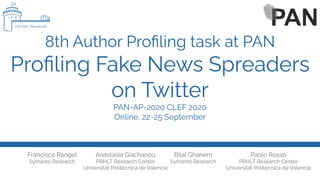Overview of the 8th Author Profiling task at PAN: Profiling Fake News Spreaders on Twitter
- 1. 8th Author Pro’¼üling task at PAN Pro’¼üling Fake News Spreaders on Twitter PAN-AP-2020 CLEF 2020 Online, 22-25 September Francisco Rangel Symanto Research Paolo Rosso PRHLT Research Center Universitat Polit├©cnica de Valencia Bilal Ghanem Symanto Research Anastasia Giachanou PRHLT Research Center Universitat Polit├©cnica de Valencia
- 2. Introduction Author pro’¼üling aims at identifying personal traits such as age, gender, personality traits, native language, language varietyŌĆ” from writings? This is crucial for: - Marketing. - Security. - Forensics. 2 Author Profiling PANŌĆÖ20
- 3. Task goal Given a Twitter feed, determine whether its author is keen to spread fake news or not. 3 Author Profiling Two languages: English Spanish PANŌĆÖ20
- 4. Corpus 4 Author Profiling PANŌĆÖ20 (EN) English (ES) Spanish Keen to spread fake news Not keen to spread fake news Total Keen to spread fake news Not keen to spread fake news Total Training 150 150 300 150 150 300 Test 100 100 200 100 100 200 Total 250 250 500 250 250 500 Methodology 1. Selection of fake news from Politifact and Snopes related sites (+ manual review). 2. Collection of tweets responding to the previous news: 2.1. Manual inspection to ensure that the tweet refers to the news. 2.2. Manual annotation of those tweets supporting vs. rejecting the news. 3. Timeline collection 3.1. Manual review of the tweets to label the fake ones. 3.2. Users with one of more fake tweets are keen to spread them. Otherwise, they are not. 3.3. Removal of tweets referring explicitly to the fake news (to avoid bias).
- 5. Evaluation measures 5 Author Profiling PANŌĆÖ20 The accuracy is calculated per language and averaged:
- 6. Baselines 6 Author Profiling PANŌĆÖ20 RANDOM A baseline that randomly generates the predictions among the different classes LSTM An Long Short-Term Memory neural network that uses FastTex embeddings to represent texts. CHAR N-GRAMS With values for $n$ from 2 to 6, with a SVM WORD N-GRAMS With values for $n$ from 1 to 3, with a Neural Network EIN The Emotionally-Infused Neural (EIN) network with word embedding and emotional features as the input of an LSTM Symanto (LDSE) This method represents documents on the basis of the probability distribution of occurrence of their words in the different classes. The key concept of LDSE is a weight, representing the probability of a term to belong to one of the different categories: fake news spreaders / non-spreader. The distribution of weights for a given document should be closer to the weights of its corresponding category. LDSE takes advantage of the whole vocabulary
- 7. 66 participants 33 working notes 22 countries 7 Author Profiling PANŌĆÖ20 Participation https://mapchart.net/world.html
- 9. Approaches - Preprocessing 9 Author Profiling Twitter elements (RT, VIA, FAV) Giglou; Hashemi; Pinnaparaju Emojis and other non-alphanumeric chars Buda; Pinnaparaju; Vogel; Giglou; Espinosa; Majumder; Lichouri; Shashirekha Lemmatisation Giglou; Hashemi; Lichouri; Shashirekha Tokenisation Vogel; Labadie; Fern├Īndez; Espinosa; Lichouri; Shashirekha; Baruah Punctuation signs Vogel; Koloski; Giglou; Espinosa; Hashemi; Lichouri; Shashirekha Numbers Pizarro; Vogel; Giglou; Espinosa; Hashemi; Shashirekha Lowercase Buda; Pizarro; Vogel; Pinnaparaju Stopwords Vogel; Koloski; Giglou; Espinosa; Hashemi; Lichouri; Shashirekha Character flooding Vogel; Labadie Infrequent terms Ikade Short texts Vogel PANŌĆÖ20
- 10. Approaches - Features 10 Author Profiling Stylistic features: - Number of occurrences - Verbs, adjs, pronouns - Number of hashtags, mentions, URLs... - Capital vs. lower letters - Punctuation marks - ... Manna; Buda; Lichouri; Justin; Niven; Russo; H├Črtenhuemer; Cardaioli; Spezanno; Ogaltsov; Labadie; Hashemi; Moreno-Sandoval; N-gram models Pizarro; Espinosa; Vogel; Koloski; L├│pez-Fern├Īndez; Vijayasaradhi; Buda; Lichouri; Justin; H├Črtenhuemer; Spezanno; Aguirrezabal; Shashirekha; Babaei; Labadie; Hashemi; Emotional and personality features Justin; Niven; Russo; H├Črtenhuemer; Espinosa; Cardaioli; Spezanno; Moreno-Sandoval; Embeddings Justin; H├Črtenhuemer; Aguirrezabal; Ogaltsov; Shashirekha; Babaei; Labadie; Hashemi; Cilet; Majumder; ...BERT Spezanno; Kaushik; Baruah; Chien; PANŌĆÖ20 * 9 teams have used Symanto API to obtain psycholinguistic and/or emotional features
- 11. Approaches - Methods 11 Author Profiling SVM Pizarro; Vogel; Koloski; Espinosa; Fern├Īndez; Hashemi; Lichouri; Aguirrezabal; Fersini Logistic regression Buda; Vogel; Koloski; H├Črtennhuemer; Pinnaparaju; Aguirrezabal; Manna Random Forest Cardaioli; Espinosa; Hashemi; Aguirrezabal; Sandoval; Manna Ensembles Ikade; Shrestha; Shashirekha; Niven Multilayer Perceptron Aguerrizabal NN with Dense Layer Baruah Fully-Connected NN Giglou CNN Chilet LSTM Majumder; Labadie bi-LSTM Saeed Ensemble (GRU + CNN) Bakhteev PANŌĆÖ20
- 14. Best results at PAN'20 14 Author Profiling PANŌĆÖ20 Buda and Bolonyai - n-Grams - Stylistic features - Logistic Regression ensemble Pizarro - word and char n-grams - SVM
- 15. Conclusions ŌŚÅ Several approaches to tackle the task: ŌŚŗ n-Grams + SVM prevailing. ŌŚÅ Best results in English: ŌŚŗ Over 67% on average. ŌŚŗ Best (75%): Buda and Bolonyai - n-Grams + Stylistic features + Logistic Regression ensemble ŌŚÅ Best results in Spanish: ŌŚŗ Over 73% on average. ŌŚŗ Best (82%): Pizarro - char & word n-Grams + SVM. ŌŚÅ Error analysis: ŌŚŗ English: Ō¢Ā False positives (real news spreaders as fake news spreaders): 35.50% Ō¢Ā False negatives (fake news spreaders as real news spreaders): 30.03% ŌŚŗ Spanish: Ō¢Ā False positives (real news spreaders as fake news spreaders): 20.23% Ō¢Ā False negatives (fake news spreaders as real news spreaders): 35.09% Looking at the results, we can conclude: ŌŚÅ It is feasible to automatically identify Fake News Spreaders with high precision ŌŚŗ ...even when only textual features are used. ŌŚÅ We have to bear in mind false positives since especially in English, they sum up to one-third of the total predictions, and misclassi’¼ücation might lead to ethical or legal implications. 15 Author Profiling PANŌĆÖ20
- 17. Industry at PAN (Author Pro’¼üling) 17 Author Profiling Organisation Sponsors PANŌĆÖ20 This year, the winners of the task are (ex aequo): ŌŚÅ Jakab Buda and Flora Bolonyai, E├Čtv├Čs Lor├Īnd University, Hungary ŌŚÅ Juan Pizarro, Chile
- 18. 2021 -> HATE speech spreadeRS 18 Author Profiling PANŌĆÖ20
- 19. 19 Author Profiling On behalf of the author pro’¼üling task organisers: Thank you very much for participating and hope to see you next year!! PANŌĆÖ20



















